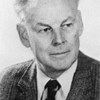On its journalistic level Ron Arnold’s At the Eye of the Storm: James Watt and the Environmentalists (Regnery-Gateway, 282 pp., $14.95) is a book about contemporary politics. Arnold’s immediate aim is to defend Jim Watt, our embattled Secretary of the Interior, from at tacks that are really aimed at Ronald Reagan. But the deeper intention of the book is to challenge the extreme modern breed of environmentalist on religious grounds. It is this aspect that will give the book its lasting value.
A former activist in the environmentalist movement, Ron Arnold quit the Sierra Club because it seemed to him it was intent on asserting a monopolistic religious claim to “the powers of salvation and healing” as it pushed its fight to preserve the landscape. The old Sierra Club had had a practical mission; it was to preserve certain chosen wilderness areas and to foster outdoor activities, but not at the cost of denying people the “wise use” of necessary range lands, forests and mineral deposits. Although John Muir, the patron saint of the Sierra Club, could be pretty mystical in his nature worship (“the groves were God’s first temples”), the Club, prior to the Nineteen Forties, still held to the old ideas about conservation promulgated by Theodore Roosevelt and Gifford Pinchot in the Bull Moose era. As a forester Pinchot applied the ideas specifically to the federal forest lands. Save for the wooded portions of our national parks, the federal forests were to be put on a “sustained yield” basis, with new seedlings taking the place of mature trees as they were “farmed” for lumber just short of their imminent decay. Conservation vs. Preservation With Teddy Roosevelt and Gifford Pinchot, conservation was not to be confused with preservation. There was a point in preserving sequoia and redwood trees, which had century-long lives. But “preservationism,” when applied on a dogmatic basis to forests of Douglas fir and Sitka spruce, would result in ecological museums filled, eventually, with old and rotting trunks of no esthetic beauty and little economic value. In brief, Roosevelt and Pinchot believed in trusteeship. They were for complete preservation of natural wonders. But “multiple use” should prevail in the rest of the federal patrimony. The conservation ethic was perfectly compatible with a belief in economic expansion. But the preservation ethic, which has taken over in all advanced environmentalist circles, looks upon economic expansion with jaundiced eyes. Belief in the orderly, efficient use of resources to give opportunity to more people, and to raise the general standard of living, is regarded by the preservationists as a desecration. With the preservationists, development is a crime. Naturally, when Jim Watt, as a believer in the traditional idea of conservation as “wise use,” became Secretary of the Interior, the preservationists took immediate alarm. All that they knew of Jim Watt was that he had, as head of the Mountain States Legal Foundation in Colorado, taken the side of industry in some disputes that grew out of arguments about multiple use. The preservationists jumped to the conclusion that anyone who would defend a business interest in an environmental matter must be for lumbering or encouraging mining exploration in the national parks. Watt, manifestly, had the wrong religion: he believed in a Christian God, not the mystical God of Nature. So the campaign against Watt roared into high before anyone had really taken a proper measure of the man. Actually, as Ron Arnold explains it, Watt’s ambitions, as Secretary of the Interior, would meet with the full approval of Teddy Roosevelt and Gifford Pinchot. Arnold tells of the first meeting of Watt with President Reagan. There was instant rapport between the two men. Within a few minutes they had settled on five major Department of Interior objectives. The first would be to open up the public lands to multiple use in the classic Teddy Roosevelt manner. The second was to reduce our national energy dependence—which meant spurring offshore oil development. A third objective was to establish a national metals policy, which could begin with an inventory of minerals in the public domain. Fourth, the deterioration of the National Parks must be halted. And fifth, leadership in the Department of the Interior should be provided by paying special attention to what Watt described as “management by objectives.” A Proper Minerals Policy Ron Arnold’s point is that there is nothing subversive of conservation-ism in the five-point agenda decided upon by Reagan and Watt. But when Watt began looking into metals policy matters he discovered that 42 per cent of federal land was closed to mineral entry, and an additional 25 per cent was “highly or moderately restricted.” There were eighty different laws, executive orders and regulations dealing with non-fuel minerals. So finding a proper minerals policy inevitably meant stepping on a few toes. Watt has offered to resign as Secretary of the Interior any time the President asks for it. Since the implacables of the environmentalist movement remain dedicated to the idea of getting rid of the man who enjoys the wilderness without feeling called upon to worship it, Watt may be gone before Reagan completes his first term. But the problems posed by the environmentalists’ animus against development, or the “wise use” of resources, will remain. Resources are for people. The co-bait that might be found in Idaho cannot rightly be allowed to remain in the ground when our defense industries need it. Nor can we refuse to harvest trees when lumber is required for new homes for the Baby Boom generation.
John Chamberlain’s book reviews have been a regular feature of The Freeman since 1950. We are doubly grateful to John and to Henry Regnery for now making available John’s autobiography, A Life with the Printed Word. Copies of this remarkable account of a man and his times—our times—are available at $12.95 from The Foundation for Economic Education, Irvington-on-Hudson, New York 10533.

